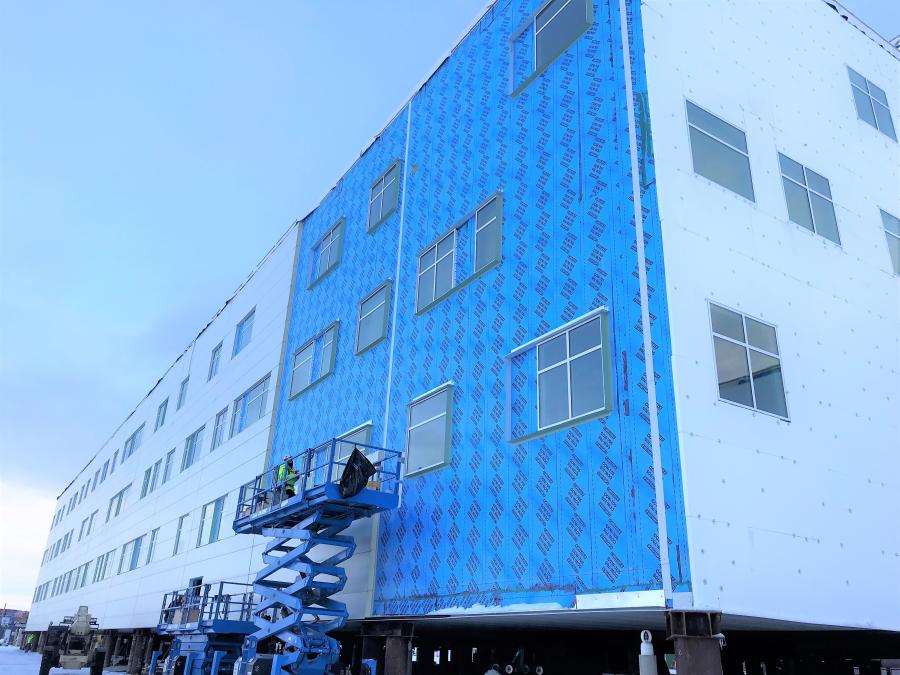The building is designed to be a certified LEED silver building, which means a focus on utilizing local and green materials.
As changing weather patterns lead to an ever-warming earth, contractors on a $300 million hospital project in Alaska are taking a tip from the Alaska oil pipeline, installing 16-in. diameter steel pilings drilled 55-ft.-deep that essentially keep the earth cold.
“We are using thermal piles that are carbon dioxide charged refrigeration piling,” said Kent Crandall, project manager for Arcadis, the global design and consultancy firm overseeing the construction of the new Dr. Paul John Calricaraq Project (PJCP). “It's quite similar to what's used on the Alaska pipeline. In the winter, when it gets down below 25, they essentially extract heat from the ground. It is a closed loop system. The gas that is in these charged tubes evaporates at a very cold temperature, like 25 degrees, and evaporates up into the radiators; the heat is dispelled, chilled down again, and turns back into a liquid, falls to the bottom and the cycle repeats. As long as it is cold outside, it is free refrigeration.”
The five-year project began in the fall of 2016 and is set for completion in 2021. It includes the new construction of the 206,000-sq.-ft. PJCP, a primary care clinic and acute nursing unit, and renovations to the existing 85,500-sq.-ft. Yukon-Kuskokwim Delta Regional Hospital.
The thermal probes are not the only departure from typical construction practices — albeit routine in the Alaska climate.
Because Bethel is not on any road system, all materials and equipment must be barged in and were done so by fall before the Kuskokwim River freezes.
“There is a whole barge schedule we try to meet for the summer time months,” Crandall said. “One of the challenges is to get all the material we need to the site by the previous fall. There is no running down to the hardware store to pick up extra materials. It's all got to be shipped out and stored on site. If you need additional materials after fall, you have to fly it in. That adds cost to the project, so we try to minimize that.”
The equipment barged to the site includes a 250-ton Kobelco crane with 300-ft. boom; a Kobelco 100-ton crane with 180-ft.-boom; a Manitowoc 100-ton crane with 200-ft. boom; as well as smaller pieces such as a 10,000-lb. low man lift; 966C Caterpillar; Genie 105 and 125 lifts; four scissor lifts; and dozen small lifts for use inside.
Workers moved quickly to enclose and insulate the building, so that work could continue throughout the winter season. That was completed in the winter of 2016. The superstructure, which features 6-in. metal panel for the building's “skin,” and triple glazed windows, was finished in the spring of 2017.
“One of the unique things, the delivery style is what we call design assist,” Crandall said. “That is, we brought the contractor on board during the early design phase at about 35 percent. They have brought on subcontractors and have been reviewing the design and participating. There is a lot of technology that is available for building buildings, a lot of automation. But we are limited on the talent pool, so a lot of time we have had to stick with something less automated and therefore less sophisticated.”
Arcadis has worked on projects all over Alaska, giving the firm valuable expertise in understanding the unique challenges posed with the weather, transportation and other special conditions.
“For example, we couldn't place bat insulation in the walls to insulate the building during the winter because of the moisture generated within the building gets driven out,” said Crandall. “That insulation — because you don't have the vapor barrier on there yet — saturates both the insulation and exterior drywall on the outside of the building. All that moisture is driven from warm to cold which is why we put vapor barriers in houses and buildings. In cold climates, we try to retard that vapor from getting in there.”
The building is designed to be a certified LEED silver building, which means a focus on utilizing local and green materials.
“Mostly we tend to gravitate toward items that save energy and reduce cost from an energy perspective,” Crandall said. “Once this building is constructed, people are the biggest cost and energy is the second.”
Attracting and retaining construction workers has been difficult, prompting Arcadis to sponsor a campaign to draw workers in both Bethel and surrounding villages. There are currently 150 workers on site. Jobs there can be valuable opportunities for workers looking to gain skills and certification.
“Folks that have skills or a trade or even an interest in construction can be brought on as a laborer,” Crandall said. “One of the unique things about this project it is going on for five years. If a local person is interested in becoming a journeyman, they can work enough time to get their certification. They also are housed on site in a dormitory style structure, or in local rentals.
“Most of the trades people live and work in the 88-person man camp,” Crandall said. “They are housed, fed, all their needs are pretty much taken care of for the duration of the project. They feed them a big breakfast and pack their lunches for them and have great meals. They have steak night and lobster night. One of the keys to keeping workers happy is feed them good meals. They've got usually a bar set up with donuts, an ice cream machine and snacks. All day long, if you are hungry you can eat. They have a chef, local people to do laundry and keep it cleaned up. The workers don't have to worry about any of that.”
CEG
Today's top stories


















